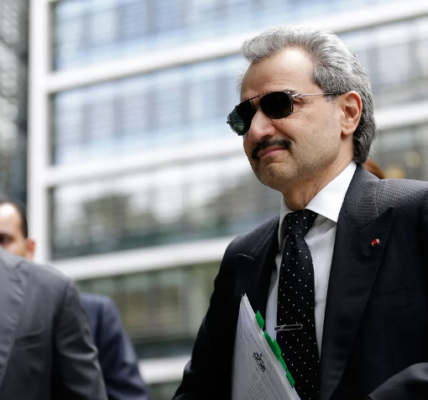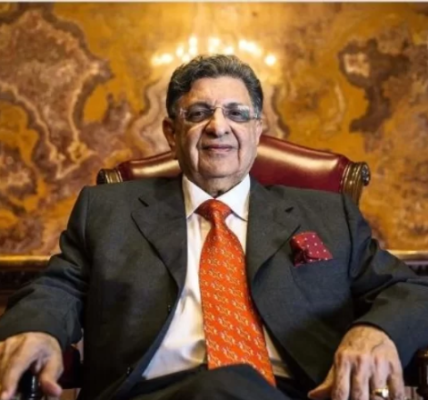In this victorious saga, we shall lay out the biographical sketch of Larry Ellison, co-originator and former CEO of the Oracle Corporation. Larry Ellison stands among the most privileged individuals globally, holding an astounding net worth of $146.8 billion as of April 2024, according to the esteemed Forbes World’s Billionaires List.
Ellison was in a giving mood, having bestowed up to 1% of his massive fortune and active involvement in The Giving Pledge endeavor.
Larry Elison joins in yachting battles with his Oracle Team USA; he takes pleasure in being a legitimate aircraft pilot and finds solace in playing tennis and strumming the guitar. A self-made businessman and billionaire, Larry Ellison triumphed through a journey marked by trials and blunders. His folks were devoid of even a cent, and his life has been a saga of compensating for his grueling youth days.
Larry Ellison’s particular persona is characterized by traits like persistence, strategic insight, and zeal for cutting-edge evolution.

Early Days
Lawrence Joseph “Larry” Ellison hailed from New York City on August 17, 1944. At that point, his mother, Florence Spellman, a lone immigrant from Odessa, was merely 19 and unequipped to rear a child. Consequently, the nine-month-old Larry was dispatched to his uncle and aunt. Larry remains unacquainted with his father, a United States Army Air Corps aircraft pilot, and was unsuspecting of the adoption until his teenage years dawned.
Her elder sister of his mother, Lillian Spellman Ellison, alongside her significant other, Louis Ellison (of Goldman origins), who dwelled in a Jewish neighborhood in Chicago, adopted Larry Ellison. His adopted father, a Russian migrant, devised the surname “Ellison” in commemoration of Ellis Island Gateway, where his passage to the United States unfolded.
It was a standard family unit, the mother epitomizing affectionate, tender, and endearing attributes while the father radiating strictness, obstinance, and demanding demeanor. Larry thrived into an independent, self-assured, and uncompromising figure, causing constant disputes and muddles with his stepfather and contemporaries later on.
Even during his academic years, Larry Ellison carried a haughty outlook. Delving chiefly into intricate realms such as spacecraft construction, high technology, and engineering, the educational process appeared mundane to him. Sporting middling academic performance, he revealed a sometimes intricate character. He sought joy in athletic endeavors, partaking in squash, volleyball, and hockey.
Post qualifying from the South Shore High School in Urbana-Champaign, Larry sauntered into the University of Illinois in the 1960s. These emerged as the initial moments of cheer in his life. An aura of frill-free futurity and abundance drifted around him. The varsity syllabus came about effortlessly to him, empowering him with a vibe of freedom and might. However, subsequent to the demise of Ellison’s adoptive mother, he abstained from partaking in the final exams and opted to drop out of the University. Following a year of part-time gigs, incessant doubts, and profound introspection, Larry Ellison enrolled at the University of Chicago with aspirations of attaining a degree in physics and mathematics. Alas, waning interest in the pedagogical procedure led to his expulsion post the first semester in 1966, at the tender age of 22.
Coping with grinding penury, Ellison’s curiosity in untouched terrains like computers and programming burgeoned, swallowing up a lion’s share of his time. To amass knowledge in programming, he immersed himself in specialized literature; in due course, he began frequenting varied interest societies and partook in specific events welcoming people akin to himself. Larry swiftly carved a niche for himself owing to his rapid learning prowess.
Early Professional Stint
Bob Miner, Larry’s boss at Ampex, metamorphosed into a confidant for Larry Ellison in 1977. However, Bob Miner saw fit to part ways with Ampex before long, initiating a company christened Software Development Laboratories (SDL) on June 16, 1977, in collaboration with Bruce Scott and Ed Oates, pouring a sum of $800 into the venture. A few moons later, Larry Ellison allied with their enterprise as a business associate and ploughed in $1,200 into the venture.
Edd Oates subsequently acquainted Miner and Ellison with a treatise by Edgar F. Codd on a relational model for database management christened “A Relational Model of Data for Large Shared Data Banks.” Larry Ellison drew inspiration from this work. Soon, their brushes splattered the landscape of a database management system (DBMS). Enterprises employed this system to archive lists of clientele, equipment particulars, financial annotations, transaction details, epistolary exchanges, legal documents, and the likes.
Oracle Systems Corporation
SDL transmuted into Relational Software Inc. in 1979. Official rechristening as Oracle Systems Corporation transpired in 1982 subsequent to the launch of their signature product, the Oracle RDBMS, a pivotal object-relational database management system. The inaugural outing of Oracle RDBMS donned the v2.0 facade; no Oracle v1.0 spawned as Ellison harbored conviction that zero individuals would opt for it.
In Ellison’s perspective, the Oracle RDBMS unfurled an array of jaw-dropping feats in that epoch: sifting through premier-performing supermarkets embedded among a vast chain of supermarkets or segregating and sieving bestseller goods and products. The Oracle RDBMS dealt magnanimously with expansive data, proving irresistible to governmental echelons and mammoth proprietorial entities. With a sagacious coterie of merely eight workers (encompassing three co-originators: Larry Ellison, Bob Miner, and Ed Oates), the company’s revenue scarcely grazed the $1 million threshold.
IBM Corporation in 1974 delved into database commodities grounded on Codd’s theories at IBM’s San Jose Research Laboratory. They intromitted IBM System R, and Ellison vouched for ensuring compatibility for Oracle products. However, IBM bigwigs brushed aside the notion of divulging System R’s essence.
Come 1982, Oracle’s revenue clocked $2.5 million realm with a bevy of 75 minuscule- and pocket-sized clients in tow. Larry Ellison infused 25 percent of the remittance into R&D in 1982 to scribe a commercially accessible and mobile Oracle RDBMS pivoted on the C programming language compiler. Oracle’s contracts with governmental agencies facilitated sufficient funds to empower their team to concentrate on commercially practicable products beefing their lucrative wares to wrest market slices from IBM and other contemporary IT enterprises.
In 1983, Oracle RDBMS of v.3 transitioned into commercial availability, enabling installation across all operating systems spanning mainframes, workstations, personal computers, microcomputers, etc. Ellison’s intuition came good, and Oracle’s commitments paid dividends by doubling the company’s revenue to $5 million. 1985 witnessed the company’s revenue sales stepping up to $23 million; as of 1986, the revenue sales hit $55 million. Oracle trained eyes on premier clienteles such as governmental agencies and the heavyweight international entities in the automobile, aerospace, pharmaceutical, and manufacturing verticals.
IPO
March 12, 1986, unfurled Oracle Systems Corporation’s IPO on the NASDAQ (ORCL) stock market debut with a debutante price tag of $15 per share that surged to $20.75 by the close of the trading session post-vending 2.1 million shares and collecting $31.5 million alongside.
Post the IPO, Larry Ellison dispatched groups foray into 17 countries for peddling Oracle’s goods in excess of 35 countries. Oracle introduced the SQL Star software heralding the era of processing and fetching data stashed across the gamut of networked computer systems.
Oracle’s Turbulent Times
1990 bequeathed Oracle with its virgin crises settling the year with an adversarial net income chart and heading into the red. The company’s market capitalization shrank by 80%, dangling precariously on the precipice of insolvency. Parallel with this ordeal, Oracle relieved 10% of its workforce, around 400 souls. The main trigger for this calamity stemmed from an overbearing marketing strategy. The sales staff badgered potential clients into snagging every feasible Oracle software at one go by pre-booking the value of future license sales within the ongoing quarter. This maneuver amplified their end-of-year bonuses, but when the anticipated sales fluttered into oblivion eventually, pandemonium unfurled in the business sphere. Being a publicly traded entity, Oracle incurred supplemental dues to extinguish class-action suits waged by shareholders arising from its exaggerated earnings records. As per Larry Ellison’s own admission, this display of business ineptitude was mind-boggling. Within this chaos, the company settled a staggering $24 million bill with its shareholders.
At the onset of the 1990s, IBM wielded superior domain supremacy in the mainframe relational database bazaar, boasting software like DB2 and SQL/DS in this niche. Contemporaneous rivals such as Sybase, Oracle, Informix, and Microsoft seized the opportunity to carve their profiles in the domain of relational database across UNIX and Windows to reign supreme in mid-range systems and microcomputers.
Jumping ahead from 1990 to 1993, Sybase was the rapidly growing entity while Oracle lagged in its wake. However, following three years punctuated by frenzied sales drives and hefty mergers, Sybase handed over all software rights to Microsoft Corporation, underscoring a significant industrial transfer. Post this shift, Informix absorbed Sybase transmuting into Oracle’s principal nemesis.
The narrative of the database contest between Informix CEO Phil White and Oracle CEO Larry Ellison embroidered Silicon Valley headlines over a triad of years until 1997, when Informix rolled out noteworthy earnings recalibrations and financial shortages. Phil White found himself incarcerated on charges of corporate malfeasance, and IBM consumed Informix in 2001 (Sybase software architects and code rounded off IBM’s DB2 software).
1997 witnessed Larry Ellison enrolling in Apple Computer’s Board of Directors upon the return of Steve Jobs to the helm. Ellison shouldered the stance of a director at Apple Computer for five years and on September 20, 2002, himself relinquished this position.
Merger and Acquisitions
The sagacious tactician that Ellison is, he orchestrated a slew of strategic moves culminating in the vanguard sectors across the market steering the course to a robust software manufacturer.
In the fall of 1994, Oracle snaffled up Rdb division, a robust relational database management system (RDBMS) from DEC. This marked the maiden acquisition by Oracle.
A pivotal cog in Ellison’s strategies was the buyout of PeopleSoft, Inc. by Oracle Corporation for a princely sum of $10.3 billion in 2004. PeopleSoft served as a pristine corporate entity boasting 12,750 clientele. It was vested in tendering human resource management systems, supply chain management, customer relationship management, financial management solutions, and enterprise performance management software.
April 29, 2008, witnessed Oracle Corporation taking the plunge by sealing the deal with BEA Systems, Inc. for a hefty $8.5 billion fetch. BEA Systems specialized in enterprise infrastructure software products. Larry Ellison was resolute in marking Oracle Corporation as the forerunner in the computer tech horizon and threw his weight behind surpassing and trailing past industry behemoths presiding over the software vanguard.
On January 27, 2010, Larry Ellison entered accord to procure Sun Microsystems, Inc. for a stellar sum of $7 billion, hailed as one among Oracle’s most famed acquisitions. Post the culmination of this transaction, Oracle set out to retail technologies, leveraging the innovation throbbing throughout the Sun Microsystems technologies.
Admittedly, IBM and SAP continue to lampoon Oracle as its arch-nemeses.
Personal Chronicles
Larry Ellison has donned the mantle of matrimony on four occasions with each bout culminating in a divorce.
In 1967, he crossed paths with his inaugural consort, Adda Quinn, amid his varsity sojourns. The duo cohabited for a septennium, concluding with Adda’s bid adieu. She harbored no grudges against him, considering him an individual rife with brilliance, unpredictability, and humor albeit an entity hard-pressed to dwell with.
Nancy Wheeler Jenkins, Larry’s second spouse, was a luminary at Stanford University. Commencing into marital bliss in 1977, Larry and Nancy’s saga imploded under pressures, culminating in Nancy’s call for severance in July 1978.
1983 unfurled in Larry Ellison’s life with Barbara Boothe as a bride, a former first-contact at Relational Software Inc. The pair escorted through four years as a harmonious entity, even begetting David and Margaret en route. Alas, this liaison took a swan dive into dissolution shelves in 1986.
Their offspring, David Ellison, spearheads Skydance Media as CEO. In recent epochs, David’s dominion has burgeoned into one of the trailed movers and shakers in Hollywood: his firm ventured to co-produce and co-finance cinematic marvels beside Paramount. Skydance Media is credited with shelling out feature-length productions like Star Track: Into the Darkness (2013), Mission Impossible: The Rogue League (2015), Star Trek Beyond (2016), and its ilk.
Their progeny, Megan Ellison (born on January 31, 1986), steers the ship for Annapurna Pictures, a notary assemblage within the cinematic spectrum. She bagged laurels for populating the silver screen with gems like Zero Dark Thirty (2012), Her (2013), and American Hustle (2013), all nominated for the Academy Awards pantheon.
The fourth stance for Larry Ellison was with Melanie Craft, a raconteur regaling in romances. Larry and Melanie sealed their union on December 18, 2003, at his palatial retreat in Woodside. The role of the official photographer was clinched by Ellison’s lamented buddy Steve Jobs, co-founder of Apple, Inc. Ellison extended the gesture of endowing 911,744 Oracle shares worth $11.9 million as a wedding token to his fourth consort, Melanie Craft. This romance tailed into the realms of annulment in the year 2010.
Larry Ellison etched his cameo on the silver screen in Iron Man 2 (2010) amid Tesla CEO Elon Musk.
Speaking of the current days, Larry Ellison finds passion amid Nikita Kahn, a Ukrainian animal rights proponent, thespian, and model arcing her signature in a fashion blog.
Private Island: Lanai
Residing the chapters of 2012, Larry rounded a pact to wrap up 98% of Lanai for $300 million, unearthing one of the eight prime islands in Hawaii, dousing him with 88,000 acres (137.50 square miles) of island laden in a parcel that hitherto bore the stamp of another magnate, David Murdock.
This roost encompassed The Lodge at Koele – twin championship golf domains and clubs, The Koele Golf Course, and The Manele Golf Course. The folio extended to embrace The Four Seasons Resorts Lanai at Manele Bay and The Four Seasons Resorts Lanai.
Larry Ellison penned a blueprint to refashion the island’s fabric, seeding the sprouts of agricultural terrain and propelling the arc of fruit and vegetable output for vending across oceans. Besides, he threaded the quest of leveraging renewable energy coyly treading the shores of refining saltwater into potable quenching essence.
Sailing Tournaments
Intruding beyond the shrouds of commerce, Larry Ellison dons the garb of the principal crew for Oracle Team USA, setting sail in 2000 as a leviathan in the American yacht syndicate domain. Treading forth with the mantle to vie for the 2003 America’s Cup, Ellison’s avatar took an initial skid. A redo unfolded carrying him across the 32nd America’s Cup, however, sans lady luck’s blessing.
February 14, 2010, unfurled the victory flag for Ellison’s trimaran USA 17 (earlier known as BMW Oracle Racing 90 or BOR90) clinching the 33rd America’s Cup (lending a brush in the 2nd race). His squadron clinched laurels in the 34th America’s Cup in 2013.
Oracle Team USA slotted into the America’s Cup World Series of 2011–13, albeit was blacklisted from the tournament on grounds of tampering on August 08, 2013. Culminating the spin, the competition arbiters unearthed unauthorized tweaks bedazzling their sailboat. The punitive consequence tabulated to a fine of $250,000 besides the expulsion of three team members and a one-point mauling remit for each of the preliminary two matches of the face-off where they would otherwise amass a point.
Larry Ellison presided over the reign of Rising Sun as the owner of the eighth most imposing yacht across the globe up until 2010 criterion, marking the epoch he parted ways with it ceding it to David Geffen. Rising Sun unfastened the moorings of a 453-foot (138 m) long yacht donning a pricetag of approximately $200 million.
Tennis
In the elapsed year of 2009, Larry Ellison sealed the deal to acquire the Indian Wells Tennis Garden, a tennis precinct on the outskirts of Palm Springs, California, undergirding the Indian Wells Masters tournament.
Aviation
Larry Ellison dons the feathers of a licensed air mariner. He stamps authority on diverse epochal aircrafts and military jets constituting SIAI-Marchetti S.211, a turbofan-powered military educator jet crafted in Italy circa 1984, and Mikoyan MiG-29, a twin-engine warbird emanating from the gallows of the Soviet Union, one with a US embargo clamped over him for importation back home.
A city tweak from the San Jose City administration in California named and shamed Larry Ellison for eclipsing the lift-off and touchdown guidelines betwixt 11:30 p.m. and 6 a.m. at the San Jose Mineta International Airport roping in the contender, Gulfstream V. Quoting a weight excess of 75,000 pounds (34,019 kg), Ellison in January 2000, filed a lawsuit in U.S. District Court versus the city of San Jose barring planes of a prescribed weight from descending betwixt 11:30 p.m. and 6 a.m.
The crux of his lawsuit pivoted around affirming that his Gulfstream V equipment merits clear onus to touch the tarmac under two guises: weighing at 75,000 pounds (34,019 kg) or 90,000 pounds (40,823 kg), reckoned for protracted trips demanding surplus fuel or augmented loads. Larry Ellison’s legal masterstroke, Ed Davis Jr., emphasized the point that the aviator effectuated only light-footed descend weighing in under 75,000 pounds, and they had data cranking out the evidence proving their stance correct.
June 2001 serenaded Larry Ellison with a magisterial nod from US District Judge Jeremy Fogel suggesting Ellison to embrace a taciturn trail from his aircraft. However, the court did not dissociate the dimout mandate.





